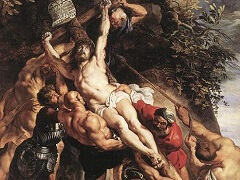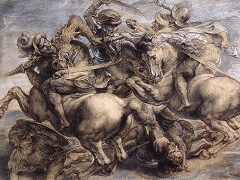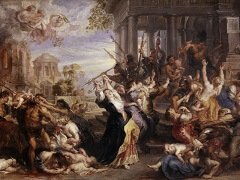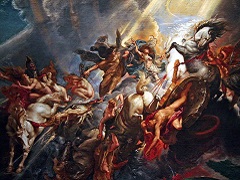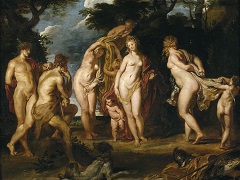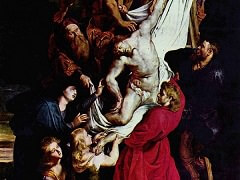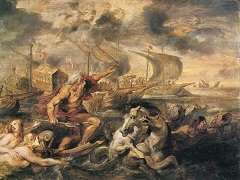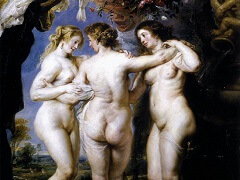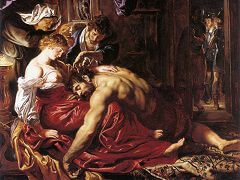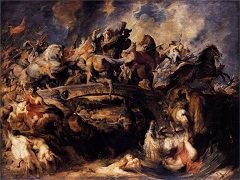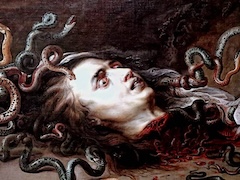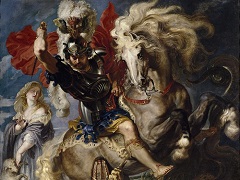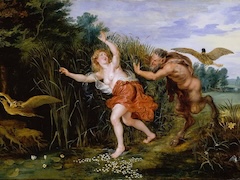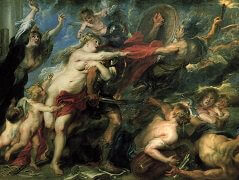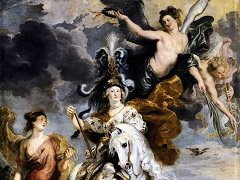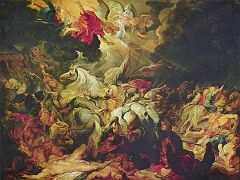Prometheus Bound, 1611-1612 by Peter Paul Rubens
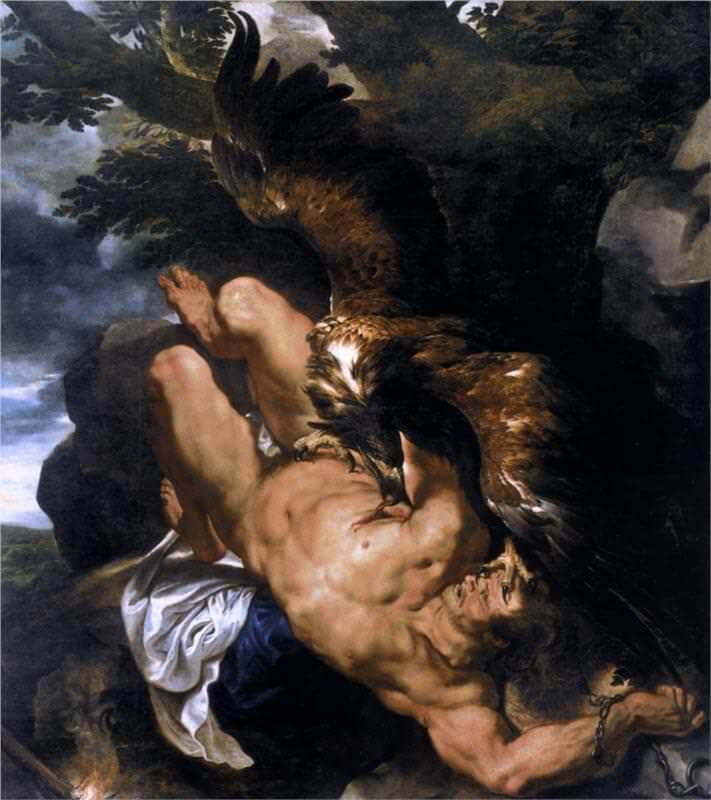
PROMETHEUS writhes in agony as a huge eagle, talons gripping his head and groin, devours his liver. The hero's nude body, powerfully muscled and steeply foreshortened, is chained at the wrist to the rock. Prometheus lies on blue and white drapery, his of the boulders on the left is a glimpse of an open landscape.
The earliest mention of this painting is in a laudatory poem composed by the Leiden University professor and acquaintance of Rubens's brother Philip, Dominicus Baudius, who sought to evoke the horrible immediacy of the work, describing the scene as if the bird were alive, and imagining flames jetting from its eyes. Baudius's poem is dated 7 April 1612, thus providing an terminus ante quern for the commencement of Rubens's work on the painting. As Julius Held observed, a date of 1611-1612 for the painting is also supported by its stylistic resemblance to the Juno and Argus, which not only employs comparable paint handling but also includes a similarly contorted nude and is documented as having been completed by 11 May 1611.2 The Prometheus evidently remained for as long as six years in Rubens's studio (or conceivably was purchased back from its owner by the artist from an intermediary owner), because it is mentioned by Rubens in a letter of 28 April 1618 to Sir Dudley Carleton, the British ambassador to The Hague. This was part of a correspondence begun the previous year in which Rubens sought to exchange several of his own paintings for a collection of ancient marbles owned by Carleton. Promoting the paintings as "the flower of my stock," Rubens listed the present painting first, describing it as "A Prometheus bound on Mount Caucasus with an eagle which pecks his liver. Original by my hand the eagle done by Snyders." Although this probably was not the first instance of the long and fruitful collaboration between Rubens and Snyders, it was an early example and the only case certified by Rubens himself. Snyders's preparatory drawing for the eagle is preserved in the British Museum. The success of this collaboration and the vitality of the eagle that so impressed Baudius would seem, as Robels noted, to give the lie to the oft-quoted letter of Tobey Matthew to Carleton purporting that it was Rubens's opinion that Snyders was not as accomplished at painting live animals as dead ones.5 Held reasonably surmised that Rubens probably conceived the composition's overall design in a lost sketch.6 This may have resembled Rubens's oil sketch of the Recognition of Philopoemen of ca. 1609, which served as the initial conception for a large version of the composition by Rubens and Snyders in the Prado.
It was at this time that the story became confused with the myth of Tityus. Tityus was the son of Earth who assaulted Leto (Latona), the mother of Apollo and Artemis, and was punished in the underworld by having his immortal liver pecked at by vul-tures. (Baudius, typically reflecting the confusion between the two myths, mistook Prometheus's attacker in the Rubens for a vulture.) Often interpreted as an allegory of the tortures of immoderate love, the Tityus subject was treated by Michelangelo in his famous drawing of 1532, now in Windsor Castle. As Oldenbourg first observed, Rubens seems to have derived features of his Prometheus from this important prototype of a figure lying in agony. Another important potential source, which also probably acknowledges the Michelangelo, was Titian's Tityus, which Rubens could have known from his trip to Spain in 1603 (the original or a faithful copy is in the Museo del Prado, Madrid) or through Cornells Cort's engraving of 1566 after the original. The latter turns the image in the same direction as in the Rubens and adds a torch, thus effectively transforming Tityus into Prometheus. Held also suggested that the formal history of Prometheus's pose could be traced to the figure of Heliodorus in The Expulsion of Heliodorus from the Temple by Raphael in the Vatican, but allowed that a reclining figure with one leg bent and the other outstretched had become virtually a formula for figures undergo-ing a painful ordeal. The famous Laocoon sculpture group from antiquity, which Rubens sketched on several occasions during his time in Rome, could also be recalled in Prometheus's tormented pose. If, as Dempsey has theorized, the Prometheus was an attempt to reconstruct the Alexandrian painter Euanthes' famous work in the Temple of Zeus at Pelusium, then Rubens's effort was an homage to the art of antiquity.

